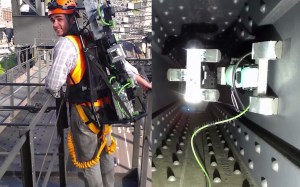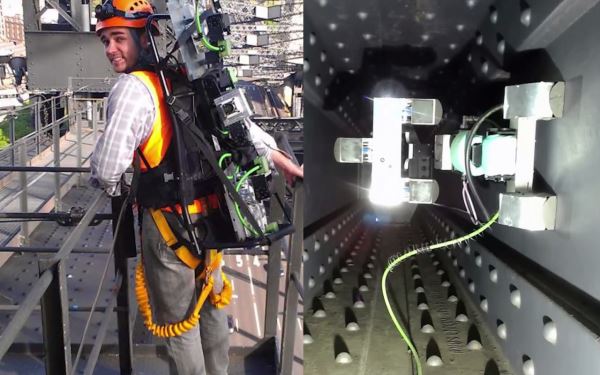When the going gets tough, the robots get going.
Robots are now playing a key role in hazardous environments across the globe to protect human lives.
Specialist robots have found an important niche successfully carrying out a range of dangerous tasks. This includes bomb disposal, underground mining, working at heights and in confined spaces, and work in radioactive and toxic environments.
A great example of this is in Fukushima, Japan, which was hit by a major earthquake in 2011.
A 15m tsunami disabled the power supply and cooling of three Fukushima Daiichi reactors, causing a major nuclear accident.
Teams of Japanese roboticists have created a small army of robots capable of surviving, if only for a few minutes, inside the compromised reactor cores.
And one of those robots recently transmitted the first photos of nuclear debris from the site.
Customised autonomous robots developed at the Robotics Institute at Carnegie Mellon University are also being used to monitor kilometres of pipes at a closed uranium enrichment plant in Piketon, Ohio in the US.
The facility has been closed since 2000 and no living creature can safely enter.
Big cost savings
Specifically, the autonomous robots will be used to identify uranium deposits on pipe walls. That work has previously fallen to humans working on scaffolding outside the pipes.
US Department of Energy officials estimate the robots could save tens of millions of dollars at Piketon and save perhaps $50 million at a similar uranium enrichment plant in Paducah, Kentucky.
“This will transform the way measurements of uranium deposits are made from now on," says William "Red" Whittaker, robotics professor and director of the Field Robotics Centre at CMU.
A tetherless robot called RadPiper will manoeuvre through narrow pipes above flexible tracks.
The robot is equipped with a LiDAR as well as a fisheye camera to detect and manoeuvre around obstacles, such as closed valves.
RadPiper measures radioactivity with a "disc-collimated sensing instrument" that uses a sodium iodide sensor to count gamma rays. It then returns to its launch point after navigating each section of pipe.
Robots are also playing a major role in assisting defence forces throughout the world.
Bomb disposal robots
For the past 40 years, robots have been used to defuse bombs.
Bomb disposal robots are used to closely examine devices, without putting themselves or others in danger. Once the device has been examined, the robot can (hopefully) then render the bomb inert.
And it’s not just bombs the robots disable, but also any type of device that could detonate. This can include anything from landmines to unexploded munitions.
The key to modern bomb disposal operations is to the render the explosive ordnance device inert without causing it to detonate. Bomb disposal robots typically achieve this by firing a high-pressure jet of water at wires on the device.
An explosive device usually requires a power supply to detonate: disrupting this wire means the circuit is broken and thus rendered inert, if not safe.
However, some devices have secondary systems that can cause the device to explode if it is tampered with. This is why bomb disposal is best carried out by a robot.
New health and safety requirements
In Australia, stringent health and safety requirements have resulted in fewer workers now performing dangerous tasks like working at height, in confined spaces or in environments with poor air quality.
Employers are now sending in robots to do the dangerous jobs.
To prevent fatalities and workplace injuries robots are being developed to perform a broad range of tasks across a wide range of industries and applications.
In 2016, the Centre for Autonomous Systems and the University of Technology Sydney (UTS), developed a portable robot designed specifically for the inspection of steel infrastructure. The research has been funded by the Road and Maritime Services NSW (RMS).
The CROC autonomous climbing robot is capable of inspecting steel bridges in the transport industry, ship hulls in the maritime industry, transmission poles, power plants, nuclear reactors and off-shore structures in the energy industry.
CROC has been deployed to inspect pitch black hidden passages inside the arches of the Sydney Harbour Bridge to check for defects.
No-go zone for humans
There are more than 7km of those narrow passageways along the arches of the bridge. And they’ve become a no-go zone for humans due to the risk of asphyxiation or being wedged in the tight tunnels.
CROC is equipped with cameras and sensors and can build 3D maps and identify forbidden zones and obstacles.
This compact little bot navigates using a 3D sensor creating a map of the space to give engineers crucial information about what needs fixing.
CROC can intelligently plan its own course and avoid collisions with any obstacles identified in the environment.
A simple user interface enables inspectors to monitor the operation and view live video feeds.
The robot collects high definition images along its path which can be stored and later viewed remotely by bridge inspectors for a condition assessment.
It can pass through small manholes that can’t be accessed by humans.
Cleaning and painting
The next stage of this project will see the robot clean and paint the area at the same time. The robot will use lasers to vaporise rust and have a vacuum to remove it.
A machine attached will add a coat of paint without the need for workers to delve inside the dangerous network.
The new version of CROC is expected to be launched early next year.


